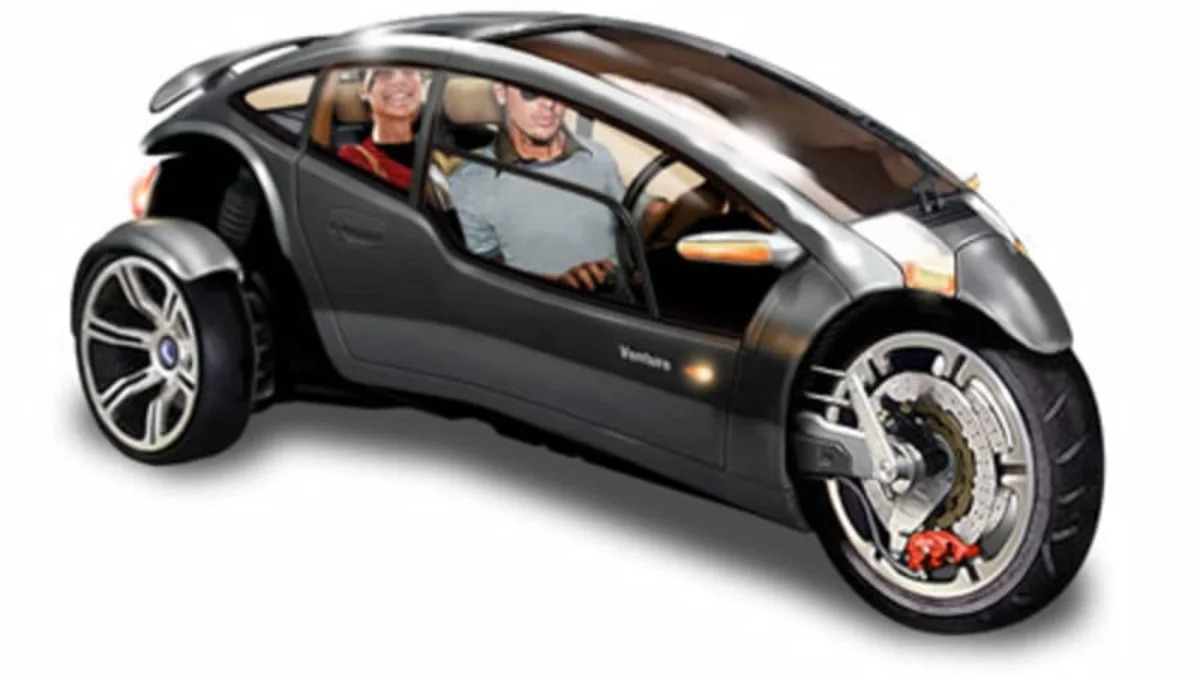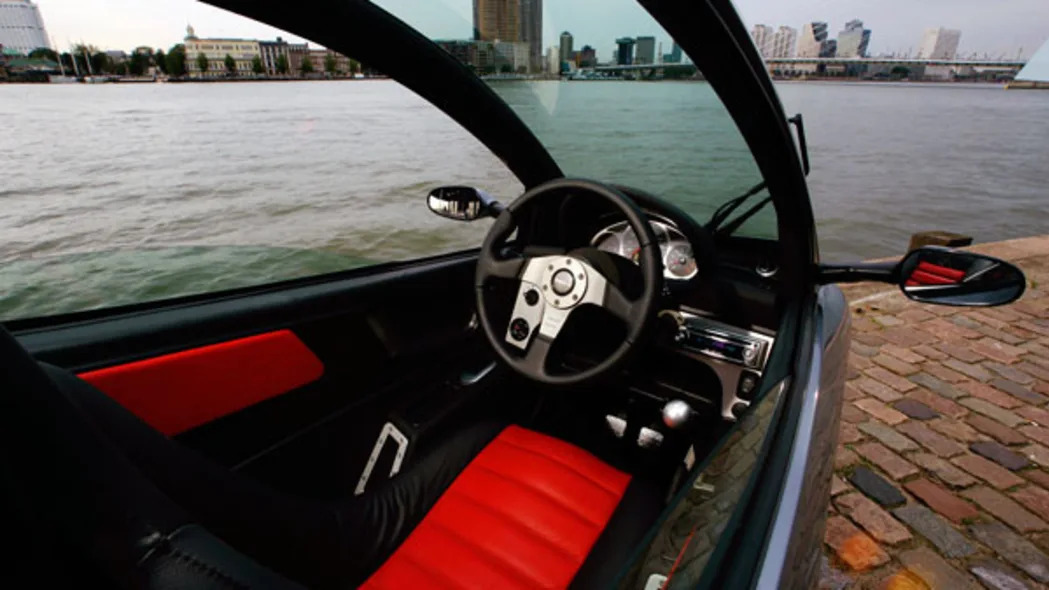Click on the image for a gallery of 29 images of the VentureOne concept and the Carver three-wheeler.
This is the second part in an interview with Ian Bruce, founder of Venture Vehicles, where he talks about safety aspects of the VentureOne concept, and projected sales growth. In the first part of the interview, Ian shared with us his background with Venture Vehicles, and comments on the design of the VentureOne. Click here to go to part one of the interview.
If you haven't already, be sure to read our guide to the VentureOne first as background to this insightful interview.
ABG: Is the small internal combustion engine used in the hybrid variant taken straight out of a motorbike? What flex-fuel capabilities does it have?
IB: The genset is the other main component in our series-hybrid configuration, and we have a great deal of flexibility in choosing the final configuration. The principal requirement is that it run efficiently while generating a sustained 15kW using standard gasoline, E100, or any blend in between. We only require a small sensor in the fuel system that can detect the relative percentage of ethanol in the fuel and adjust the injection volumes to suit. We plan to use the airflow from the battery cooling system to keep the fuel lines and engine at a minimum temperature, and avoid any cold weather start-up problems associated with E100.
Interview continues after the jump.
ABG: What challenges do you envisage in gaining road use certification for California? In particular around passenger safety?
IB: Surprisingly, we have very few problems -- the vehicle is officially classified as a motorcycle, and as such, we're under no obligation to include any safety features at all besides an adequate braking system and a properly mounted illumination system.
That's hardly appropriate, or a desirable standard for Venture Vehicles.
We plan to approach TAKATA-PETRI to assist us in developing an integrated solution to passenger safety in our vehicle. TAKATA-PETRI develops comprehensive restraint systems for car occupants -- from the mathematical model via the prototype, through to the calculated simulation and physical crash testing.
A sampling of the integral safety features we plan to include in our vehicle are:
Capture Collar: The Capture Collar is a structural feature designed to allow the front wheel and rim to compress during an accident to absorb energy from a frontal impact. The Capture Collar traps the compressing wheel assembly and transfers the energy rearward into the vehicle's frame.
This is similar to the crumple zone concept pioneered by Mercedes-Benz and first introduced on the 1953 180 "Ponton" sedan. This system works by lengthening the time a vehicle takes to come to a stop, thus reducing the magnitude of the forces and deceleration experienced by the occupants. Bottom line: a properly restrained passenger will have a smaller force applied to their bones and organs, and are more likely to survive a crash.
Steel Roll Cage: The roll cage is part of our specially constructed frame, and will protect the driver and passenger from being injured in an accident, particularly in the event of a roll-over. The roll cage also does a great deal to stiffen the chassis, which is a desirable feature in our vehicle.
Collapsible Steering Column: A collapsible steering column consists of a perforated or segmented section that collapses when the driver's body contacts the steering wheel in a frontal collision. The column, inner tube, and steering shaft collapse, taking the impact instead of the driver. This has been a standard safety feature on automobiles since the 1970s, and will be standard in our vehicle as well.
Side impact rails: The side impact rails are designed to absorb impact forces in side-impact crashes. They are currently fitted as standard to the vast majority of automobiles, and our vehicle should be no exception. These are composed of advanced high strength steels (Docol 1200 M or similar) and fitted, in our application, within the door and opposing vehicle frame.
This is an important safety focus for us, second only to frontal crashes. Side-impact crashes represented, in 2002, 26 percent of all fatal collisions with an estimated total of 782,000 nonfatal and 9,812 fatal injuries.
Driver's Airbag: In addition to front and rear 3-point seat belts, we intend to include a driver's airbag. Airbags for the front-seat passenger have been available since 1985. They offer optimum protection and minimizes injury hazards even in so-called out-of-position situations, and have saved countless lives. It's only appropriate that we offer them in our vehicle.
Collapsible Engine Mount: Designed to allow the engine module to shear laterally in a catastrophic rear collision. This needs to be investigated throughly to determine its effectiveness in enhancing passenger safety.
Engine Shield: Protects passengers, and directs engine module downward and underneath the vehicle in a catastrophic rear impact.
Rear Bumper: As the name suggests, the feature mitigates damage in rear impact. What is unusual, is its appearance on what is technically a motorcycle. As much as possible, we intend to conform to both elevation and 5 MPH impact standards for automobiles.
We are spending a considerable amount of resources engineering-in safety, and conducting crash testing -- both simulated and actual -- for a very simple reason: It's just the right thing to do.
 ABG: 1,200 lbs is very light - what materials will be used to build the VentureOne? It appears that is may be aluminium tubing covered by last panels?
ABG: 1,200 lbs is very light - what materials will be used to build the VentureOne? It appears that is may be aluminium tubing covered by last panels?
IB: Our target curb weight is indeed 1,200 lbs. Even so, we've decided to use 4130 chrome-moly steel for the main chassis elements, including the roll-cage. Aluminum was considered, but we wouldn't gain the same benefits that you'd see in a wider vehicle. Besides, it's more expensive and tricky to bond properly. The exterior body panels themselves are molded-in-color, recyclable thermoplastics. Like a motorcycle, they're aerodynamic elements, and non-structural.
ABG: Have you lifted the molded-in-color, recyclable thermoplastics technology straight from the motorcycle industry? Were there challenges in adapting this technology to the larger body panels of the VentureOne?
IB: Actually, it's already being done for vehicles like the Smart Car. I'm nearly positive the front and rear bumper of your own personal car, as well as many other components, are thermoplastics of one sort or another. Plastal, a leading supplier of injection-moulded and surface-treated plastic based in Sweden, produces the body panels for Smart, as well as many other manufacturers.
ABG: Where will the VentureOne be built and how many are you expecting to produce? Are you looking to export them to other countries?
IB: We've had our forecasting and competitive analysis performed by AutoPacific in California. Based on a staged rollout beginning in only California for the first year, our US numbers look like this:
Annual Vehicle Sales
Using similar facilities as a guide, we anticipate a manufacturing capacity of 18,000 vehicles per year. Running two shifts, that capacity is doubled to over 36,000 vehicles per year, per facility. As these assembly facilities are turn-key – requiring only 6-8 months from planning to completion – we have the opportunity to establish them within the countries we actually sell to, keeping the jobs local.
The use of molded-in-color, recyclable, thermoplastic body panels also eliminates the need for a paint and coating operation in vehicle manufacture – saving us considerable cost, time, complexity, and issues such as hazardous-chemical abatement compliance.
This is the second part in an interview with Ian Bruce, founder of Venture Vehicles, where he talks about safety aspects of the VentureOne concept, and projected sales growth. In the first part of the interview, Ian shared with us his background with Venture Vehicles, and comments on the design of the VentureOne. Click here to go to part one of the interview.
If you haven't already, be sure to read our guide to the VentureOne first as background to this insightful interview.
ABG: Is the small internal combustion engine used in the hybrid variant taken straight out of a motorbike? What flex-fuel capabilities does it have?
IB: The genset is the other main component in our series-hybrid configuration, and we have a great deal of flexibility in choosing the final configuration. The principal requirement is that it run efficiently while generating a sustained 15kW using standard gasoline, E100, or any blend in between. We only require a small sensor in the fuel system that can detect the relative percentage of ethanol in the fuel and adjust the injection volumes to suit. We plan to use the airflow from the battery cooling system to keep the fuel lines and engine at a minimum temperature, and avoid any cold weather start-up problems associated with E100.
Interview continues after the jump.
ABG: What challenges do you envisage in gaining road use certification for California? In particular around passenger safety?
IB: Surprisingly, we have very few problems -- the vehicle is officially classified as a motorcycle, and as such, we're under no obligation to include any safety features at all besides an adequate braking system and a properly mounted illumination system.
That's hardly appropriate, or a desirable standard for Venture Vehicles.
We plan to approach TAKATA-PETRI to assist us in developing an integrated solution to passenger safety in our vehicle. TAKATA-PETRI develops comprehensive restraint systems for car occupants -- from the mathematical model via the prototype, through to the calculated simulation and physical crash testing.
A sampling of the integral safety features we plan to include in our vehicle are:
Capture Collar: The Capture Collar is a structural feature designed to allow the front wheel and rim to compress during an accident to absorb energy from a frontal impact. The Capture Collar traps the compressing wheel assembly and transfers the energy rearward into the vehicle's frame.
This is similar to the crumple zone concept pioneered by Mercedes-Benz and first introduced on the 1953 180 "Ponton" sedan. This system works by lengthening the time a vehicle takes to come to a stop, thus reducing the magnitude of the forces and deceleration experienced by the occupants. Bottom line: a properly restrained passenger will have a smaller force applied to their bones and organs, and are more likely to survive a crash.
Steel Roll Cage: The roll cage is part of our specially constructed frame, and will protect the driver and passenger from being injured in an accident, particularly in the event of a roll-over. The roll cage also does a great deal to stiffen the chassis, which is a desirable feature in our vehicle.
Collapsible Steering Column: A collapsible steering column consists of a perforated or segmented section that collapses when the driver's body contacts the steering wheel in a frontal collision. The column, inner tube, and steering shaft collapse, taking the impact instead of the driver. This has been a standard safety feature on automobiles since the 1970s, and will be standard in our vehicle as well.
Side impact rails: The side impact rails are designed to absorb impact forces in side-impact crashes. They are currently fitted as standard to the vast majority of automobiles, and our vehicle should be no exception. These are composed of advanced high strength steels (Docol 1200 M or similar) and fitted, in our application, within the door and opposing vehicle frame.
This is an important safety focus for us, second only to frontal crashes. Side-impact crashes represented, in 2002, 26 percent of all fatal collisions with an estimated total of 782,000 nonfatal and 9,812 fatal injuries.
Driver's Airbag: In addition to front and rear 3-point seat belts, we intend to include a driver's airbag. Airbags for the front-seat passenger have been available since 1985. They offer optimum protection and minimizes injury hazards even in so-called out-of-position situations, and have saved countless lives. It's only appropriate that we offer them in our vehicle.
Collapsible Engine Mount: Designed to allow the engine module to shear laterally in a catastrophic rear collision. This needs to be investigated throughly to determine its effectiveness in enhancing passenger safety.
Engine Shield: Protects passengers, and directs engine module downward and underneath the vehicle in a catastrophic rear impact.
Rear Bumper: As the name suggests, the feature mitigates damage in rear impact. What is unusual, is its appearance on what is technically a motorcycle. As much as possible, we intend to conform to both elevation and 5 MPH impact standards for automobiles.
We are spending a considerable amount of resources engineering-in safety, and conducting crash testing -- both simulated and actual -- for a very simple reason: It's just the right thing to do.
 ABG: 1,200 lbs is very light - what materials will be used to build the VentureOne? It appears that is may be aluminium tubing covered by last panels?
ABG: 1,200 lbs is very light - what materials will be used to build the VentureOne? It appears that is may be aluminium tubing covered by last panels?
IB: Our target curb weight is indeed 1,200 lbs. Even so, we've decided to use 4130 chrome-moly steel for the main chassis elements, including the roll-cage. Aluminum was considered, but we wouldn't gain the same benefits that you'd see in a wider vehicle. Besides, it's more expensive and tricky to bond properly. The exterior body panels themselves are molded-in-color, recyclable thermoplastics. Like a motorcycle, they're aerodynamic elements, and non-structural.
ABG: Have you lifted the molded-in-color, recyclable thermoplastics technology straight from the motorcycle industry? Were there challenges in adapting this technology to the larger body panels of the VentureOne?
IB: Actually, it's already being done for vehicles like the Smart Car. I'm nearly positive the front and rear bumper of your own personal car, as well as many other components, are thermoplastics of one sort or another. Plastal, a leading supplier of injection-moulded and surface-treated plastic based in Sweden, produces the body panels for Smart, as well as many other manufacturers.
ABG: Where will the VentureOne be built and how many are you expecting to produce? Are you looking to export them to other countries?
IB: We've had our forecasting and competitive analysis performed by AutoPacific in California. Based on a staged rollout beginning in only California for the first year, our US numbers look like this:
Annual Vehicle Sales
- Year 1: 4,300
- Year 2: 11,000
- Year 3: 31,800
- 3-Year Aggregate 47,100
Using similar facilities as a guide, we anticipate a manufacturing capacity of 18,000 vehicles per year. Running two shifts, that capacity is doubled to over 36,000 vehicles per year, per facility. As these assembly facilities are turn-key – requiring only 6-8 months from planning to completion – we have the opportunity to establish them within the countries we actually sell to, keeping the jobs local.
The use of molded-in-color, recyclable, thermoplastic body panels also eliminates the need for a paint and coating operation in vehicle manufacture – saving us considerable cost, time, complexity, and issues such as hazardous-chemical abatement compliance.
I'd like to thank Ian Bruce for his time in answering all of my questions and for sharing with us more background and insight to the exciting VentureOne concept. I look forward to following the development of this exciting new vehicle as it proceeds through design and testing to production.



Sign in to post
Please sign in to leave a comment.
Continue